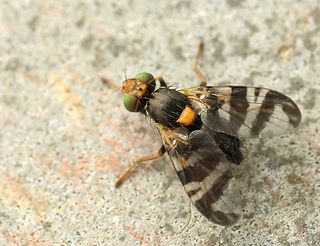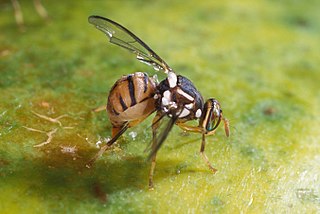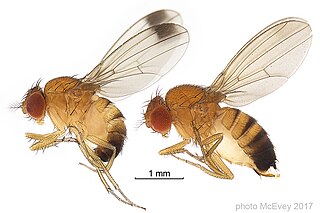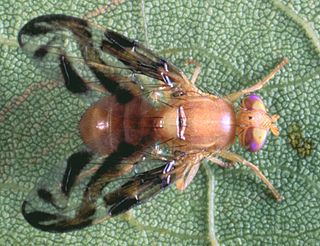
Flies are insects of the order Diptera, the name being derived from the Greek δι- di- "two", and πτερόν pteron "wing". Insects of this order use only a single pair of wings to fly, the hindwings having evolved into advanced mechanosensory organs known as halteres, which act as high-speed sensors of rotational movement and allow dipterans to perform advanced aerobatics. Diptera is a large order containing an estimated 1,000,000 species including horse-flies, crane flies, hoverflies and others, although only about 125,000 species have been described.

A pupa is the life stage of some insects undergoing transformation between immature and mature stages. Insects that go through a pupal stage are holometabolous: they go through four distinct stages in their life cycle, the stages thereof being egg, larva, pupa, and imago. The processes of entering and completing the pupal stage are controlled by the insect's hormones, especially juvenile hormone, prothoracicotropic hormone, and ecdysone. The act of becoming a pupa is called pupation, and the act of emerging from the pupal case is called eclosion or emergence.

The apple maggot, also known as the railroad worm, is a species of fruit fly, and a pest of several types of fruits, especially apples. This species evolved about 150 years ago through a sympatric shift from the native host hawthorn to the domesticated apple species Malus domestica in the northeastern United States. This fly is believed to have been accidentally spread to the western United States from the endemic eastern United States region through contaminated apples at multiple points throughout the 20th century. The apple maggot uses Batesian mimicry as a method of defense, with coloration resembling that of the forelegs and pedipalps of a jumping spider.
Holometabolism, also called complete metamorphosis, is a form of insect development which includes four life stages: egg, larva, pupa, and imago. Holometabolism is a synapomorphic trait of all insects in the superorder Endopterygota. Immature stages of holometabolous insects are very different from the mature stage. In some species the holometabolous life cycle prevents larvae from competing with adults because they inhabit different ecological niches. The morphology and behavior of each stage are adapted for different activities. For example, larval traits maximize feeding, growth, and development, while adult traits enable dispersal, mating, and egg laying. Some species of holometabolous insects protect and feed their offspring. Other insect developmental strategies include ametabolism and hemimetabolism.

Leptoconops torrens is a species of small biting flies in the no-see-um family Ceratopogonidae. They were first mentioned in writing by Charles Henry Tyler Townsend in 1893. The name Leptoconops carteri is a junior synonym of L. torrens. They are prevalent in the southwestern and southeastern areas of the United States. In early stages of life, L. torrens flies dwell in soil, then emerge to feed and breed as fully developed adults.

The Tephritidae are one of two fly families referred to as fruit flies, the other family being the Drosophilidae. The family Tephritidae does not include the biological model organisms of the genus Drosophila, which is often called the "common fruit fly". Nearly 5,000 described species of tephritid fruit fly are categorized in almost 500 genera of the Tephritidae. Description, recategorization, and genetic analyses are constantly changing the taxonomy of this family. To distinguish them from the Drosophilidae, the Tephritidae are sometimes called peacock flies, in reference to their elaborate and colorful markings. The name comes from the Greek τεφρος, tephros, meaning "ash grey". They are found in all the biogeographic realms.

The codling moth is a member of the Lepidopteran family Tortricidae. They are major pests to agricultural crops, mainly fruits such as apples and pears. Because the larvae are not able to feed on leaves, they are highly dependent on fruits as a food source and thus have a significant impact on crops. The caterpillars bore into fruit and stop it from growing, which leads to premature ripening. Various means of control, including chemical, biological, and preventive, have been implemented. This moth has a widespread distribution, being found on six continents. Adaptive behavior such as diapause and multiple generations per breeding season have allowed this moth to persist even during years of bad climatic conditions.

Rhagoletis is a genus of tephritid fruit flies with about 70 species.

Bactrocera dorsalis, previously known as Dacus dorsalis and commonly referred to as the oriental fruit fly, is a species of tephritid fruit fly that is endemic to Southeast Asia. It is one of the major pest species in the genus Bactrocera with a broad host range of cultivated and wild fruits. Male B. dorsalis respond strongly to methyl eugenol, which is used to monitor and estimate populations, as well as to annihilate males as a form of pest control. They are also important pollinators and visitors of wild orchids, Bulbophyllum cheiri and Bulbophyllum vinaceum in Southeast Asia, which lure the flies using methyl eugenol.

Rhagoletis mendax is a species of tephritid fruit fly known by the common name blueberry maggot. The blueberry maggot is closely related to the apple maggot, a larger fruit fly in the same genus. It is a major pest of plant species in the Ericaceae family, such as blueberry, cranberry, and huckleberry. The larva is 5 to 8 mm long, apodous, and white with chewing mouthparts. Female adults are 4.75mm in length, males are slightly smaller. Both adults are mostly black in color with white stripes, orange-red eyes, and a single pair of clear wings with black banding. The adult female fly lays a single egg per blueberry, and when the larva hatches it consumes the fruit, usually finishing the entire berry in under 3 weeks and rendering it unmarketable. The larva then falls to the soil and pupates. Adult flies emerge, mate, and females oviposit when blueberry plants are producing fruit. Each female fly can lay 25 to 100 eggs in their lifetime.

Rhagoletis cerasi is a species of fruit fly in the family Tephritidae.
Rhagoletis juglandis, also known as the walnut husk fly, is a species of tephritid or fruit fly in the family Tephritidae. It is closely related to the walnut husk maggot Rhagoletis suavis. This species of fly belongs to the R. suavis group, which has a natural history consistent with allopatric speciation. The flies belonging to this group are morphologically distinguishable.

Drosophila suzukii, commonly called the spotted wing drosophila or SWD, is a fruit fly. D. suzukii, originally from southeast Asia, is becoming a major pest species in America and Europe, because it infests fruit early during the ripening stage, in contrast with other Drosophila species that infest only rotting fruit.
Sarcophaga crassipalpis is a species of flesh flies (insects in the family Sarcophagidae.

Trichopoda pennipes is a species of feather-legged fly in the dipteran family Tachinidae.

Cadra calidella, the dried fruit or date moth, is a species of snout moth in the genus Cadra and commonly mistaken for the species Cadra figulilella. It thrives in warmer conditions and is found primarily in Mediterranean countries, although it can also be found in Central Asia, Kazakhstan, Transcaucasia, Caucasus, and the western part of Russia. It feeds on dried fruits, carobs, nuts and seeds, hence earning its colloquial name. This diet damages the food industry, and it is a common storage pest. Because of this, much research has been done to study ways to limit its reproduction rate and population size. It was first described by Achille Guenée in 1845.

Anastrepha suspensa, known as the Caribbean fruit fly, the Greater Antillean fruit fly, guava fruit fly, or the Caribfly, is a species of tephritid fruit fly. As the names suggest, these flies feed on and develop in a variety of fruits, primarily in the Caribbean. They mainly infest mature to overripe fruits. While thought to have originated in Cuba, the Caribbean fruit fly can now also be found in Florida, Hispaniola, and Puerto Rico.

A gnat is any of many species of tiny flying insects in the dipterid suborder Nematocera, especially those in the families Mycetophilidae, Anisopodidae and Sciaridae. They can be both biting and non-biting. Most often they fly in large numbers, called clouds. "Gnat" is a loose descriptive category rather than a phylogenetic or other technical term, so there is no scientific consensus on what constitutes a gnat. Some entomologists consider only non-biting flies to be gnats. Certain universities and institutes also distinguish eye gnats: the Smithsonian Institution describes them as "non-biting flies, no bigger than a few grains of salt, ... attracted to fluids secreted by your eyes".

Bactrocera carambolae, also known as the carambola fruit fly, is a fruit fly species in the family Tephritidae, and is native to Asia. This species was discovered by Drew and Hancock in 1994.

Anastrepha fraterculus, known as the South American fruit fly, is a fruit fly species from the genus Anastrepha. A. fraterculus is a polyphagous, frugivorous fly that is a significant pest of commercial fruit production in South America.















